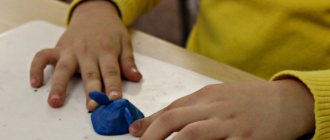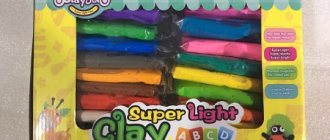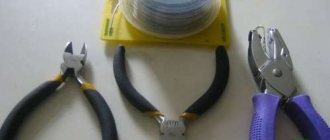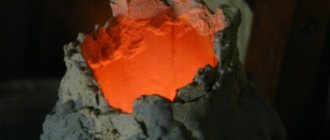Needlework
05.23.2018 Anastasia Prozheva
To make it easier for a child to learn school material, there are visual aids. And in order to learn to think on a “universal scale,” the universe must fit on his desk. And this is a great opportunity to show your creativity and, together with your child, make a model of the solar system with your own hands.
Joint creativity between parents and children always has a beneficial effect on friendly and trusting relationships between them. And in this case, it also has a cognitive purpose that will broaden the horizons of not only the child, but also the adult. Our solar system includes the Sun and nine planets with their satellites.
These are Mercury, Venus, Earth, Mars, Jupiter, Saturn, Uranus, Neptune, Pluto. They have different sizes, colors and at different distances from the Sun. This must be taken into account when making a model of the solar system.
In the model we simulate only planets, but if desired, we can also designate their satellites. To maintain the sizes of the planets in relation to each other, you can use the photo as a guide:
An endless universe of crafts
So how can you make a solar system model for kids at minimal cost? There are several ways.
The most primitive model of the solar system can be made from plasticine or salt dough, painted in the desired colors. It is suitable for the smallest babies.
This model will give the child an idea that all planets revolve around the sun and their number.
- let's blind the orange sun;
- brown-orange Mercury;
- in the same color we sculpt Venus;
- the Earth will be blue and green;
- black-red Mars;
- Jupiter will be brown;
- Saturn is blinded with rings;
- Uranium will be made of blue + gray mass;
- We make Neptune out of blue;
- gray Pluto.
We string all the “planets” onto wooden skewers and attach them to the “Sun”. For greater clarity, skewers can be made of different lengths. Ready.
Related article: How to weave a turtle from rubber bands step by step on a slingshot and on a machine
A plasticine model can be made on a plane:
As a gift for a little schoolchild, you can make a model of the solar system from papier-mâché.
Papier-mâché (translated from French as “chewed paper”) is a plastic mass made from paper with the addition of binders and adhesives (starch, gypsum, glue).
A paper layout is the simplest and most affordable to make. A detailed master class with photos will help you make it.
Materials for work:
- newspaper;
- gray toilet paper;
- office glue;
- plywood sheet;
- colored gouache paints;
- quick-drying blue paint;
- some silver beads.
Make a ball of newspaper soaked in water.
We wrap it with toilet paper and roll this lump into a bun. Lubricate the paper bun with glue, spreading it evenly over the surface.
Leave the balls to dry at room temperature or on a radiator.
While the parts are drying, let’s prepare the basis of the layout: we cut out a circle of the required size from plywood, taking into account the size of the prepared planets. We paint it with blue paint.
We make scatterings of stars from silver-colored beads, evenly distributing them on a circle, according to the picture of the starry sky.
We paint the dried koloboks, imitating the color of the planets.
We will make the rings of Saturn from silver paper.
It is imperative to accurately position the planets in relation to the Sun.
We screw screws into the bottom of the plywood, according to the location of the planets.
We screw our “planets” on top of them.
Our model of the solar system is ready.
During the manufacturing process, you can tell your child about the structure of the solar system, about the planets and everything that will be interesting to him. And such a gift will take on special meaning for him.
A wonderful idea to create a model of the solar system as an element of the interior of a children's room.
First, we decorate part of the ceiling as a starry sky.
We make planets from papier-mâché as described above.
We paint them with acrylic paints. It is more effective to use glossy ones.
Related article: Dumplings with raw potatoes
We pay a little more attention to the sun. We color and make rays from a strip of faux fur.
We attach a fishing line to the “planets” and secure them with paper clips or a stapler to the ceiling, observing the order of their location from the “Sun”.
Creating a solar system simulator
Preface
The eternal craving for something new prompted me to study such a wonderful programming language as Python. As often happens, the lack of an idea that you don’t mind spending your time on implementing greatly slowed down the process. By the will of fate, I came across a wonderful series of articles about creating a platform game in Python here and here. I decided to take on an old project. For a simulator of the movement of bodies under the influence of gravity.
Read on to see what came of it.
Part one. Theoretical
To solve a problem, you must first clearly imagine it. Suppose, by hook or by crook, we managed to get a two-dimensional section of airless space with the bodies located in it. All bodies move under the influence of gravitational forces. There is no external influence. It is necessary to construct the process of their movement relative to each other. The ease of implementation and the colorfulness of the final result will serve as an incentive and reward. Mastering Python will be a good investment in the future.
Let's introduce a coordinate system.
Let our system consist of two bodies: 1. a massive star with mass M and center (x0, y0) 2. a light planet with mass m, with center at point (x, y), speed v = (vx, vy) and acceleration a = (ax, ay).
When we manage to analyze this case, we can easily move on to complex systems with the mutual influence of stars and planets on each other. Now we will talk about the simplest things.
After simple manipulations with Newton's second law, the law of universal gravitation and similar triangles, I found that:
ax = G * M * (x0-x) / r^3 ay = G * M * (y0-y) / r^3
This allows us to create an algorithm for moving a planet in the gravitational field of a star:
1. Before starting, we set the initial position of the planet (x, y) and the initial speed (vx, vy) 2. At each step, we calculate the new acceleration using the formula above, after which we recalculate the speed and coordinates:
vx := vx + T * ax vy := vy + T * ax
x := x + T * vx y := y + T * yx
It remains to deal with the constants G and T. Let us set G = 1. For our task this is not so important. The T parameter affects the accuracy and speed of calculations. Let's also put 1 to start with.
Part two. Practical
So, my first Python program. At the same time, I would like to thank Velese again for the practical guidance.
import pygame, math from pygame import * from math import * WIN_WIDTH = 800 WIN_HEIGHT = 640 PLANET_WIDTH = 20 PLANET_HEIGHT = 20 DISPLAY = (WIN_WIDTH, WIN_HEIGHT) SPACE_COLOR = "#000022" SUN_COLOR = "yellow" PLANET_COLOR = "blue" #Sun position X0 = WIN_WIDTH // 2 Y0 = WIN_HEIGHT // 2 #Sun mass M0 = 5000 #Stop conditions CRASH_DIST = 10 OUT_DIST = 1000 def main(): #PyGame init pygame.init() screen = pygame.display.set_mode(DISPLAY) pygame.display.set_caption("Solar Mechanics v0.1") #Space init bg = Surface((WIN_WIDTH,WIN_HEIGHT)) bg.fill(Color(SPACE_COLOR)) draw.circle (bg, Color(SUN_COLOR), (X0, Y0), 10) #Timer init timer = pygame.time.Clock() #Planet init planet = Surface((PLANET_WIDTH, PLANET_HEIGHT)) planet.fill(Color(SPACE_COLOR)) draw.circle (planet, Color(PLANET_COLOR), (PLANET_WIDTH // 2, PLANET_HEIGHT // 2), 5) #Planet to Sun distance r = 0.0 #Initial planet pos, speed and accel x = 100.0 y = 290.0 vx = 0.1 vy = 1.5 ax = 0.0 ay = 0.0 done = False while not done: timer.tick(50) for e in pygame.event.get(): if e.type == QUIT: done = True break r = sqrt((x - X0)**2 + (y - Y0)**2) ax = M0 * (X0 - x) / r**3 ay = M0 * (Y0 - y) / r**3 #New spped based on accel vx += ax vy += ay #New pos based on speed x += vx y += vy screen.blit(bg, (0, 0)) screen.blit(planet, (int(x), int(y))) pygame.display.update() if r < CRASH_DIST: done = True print("Crashed") break if r > OUT_DIST: done = True print("Out of system") break #Farewell print (":-)") if __name__ == "__main__": main ()
This is what our system looks like after some time of simulation
While this note was being written, the simulator has expanded with new functionality: the number of objects in a star system is not limited, their mutual influence on each other is taken into account, the calculation part has been placed in its own class, the system configuration is specified in a separate file, and the ability to select systems has been added.
Now I'm looking for interesting system scenarios and small interface improvements.
Here's an example of what's currently in development:
If this note receives positive feedback, I promise to continue the story about a newer version.
Update:
1. I am grateful to all commentators for their critical comments. They give a lot of food for thought.
2. The project has grown. All bodies are already independent, influencing each other in accordance with the law of universal gravitation. N^2 interactions are calculated. Now it is possible to store star system configurations in external files and select at the start Code here Run like this: python3.3 main.py -f <configuration name>.ini Various configurations are there.
3. Thanks to the comments, we were able to find and eliminate the main flaw - the method for calculating coordinates. Currently the Runge-Kutta method is used. As I read Non-Rigid Problems, I will learn new methods.
Simple memos
Sometimes it is difficult for children to remember the names of objects that they do not often encounter in everyday life. To make it easier for them to memorize, adults come up with special rhymes in which the first letter of the word coincides with the first letter of the name of the object that needs to be remembered. Such poems are called mnemonic.
Probably, many in childhood learned the names and order of the colors of the rainbow from the phrase “Every Hunter Wants to Know Where the Pheasant Sits.”
Children's poems and funny phrases have also been invented to remember the names and order of the planets of the solar system. You can learn a poem by Arkady Khait with your child:
- Any of us can name all the planets in order: one - Mercury, two - Venus, three - Earth,
Four - Mars, five - Jupiter, six - Saturn, seven - Uranus, followed by Neptune.
Another well-known funny mnemonic phrase for older students:
- We Know Everything – Yulia’s Mom Got on Pills in the Morning.
Or another poem:
- There lived an astrologer on the moon,
He kept records of the planets.
Mercury - one, Venus - two, three - Earth, Four - Mars, Five - Jupiter,
Six - Saturn, Seven - Uranus, Eight - Neptune.
While making the model, the child will be happy to learn the names of the planets with the help of funny poems.
More layout options can be seen in the photo:
As you can see, making such crafts is not at all difficult. It is enough to be able to make balls from different materials and be able to use your imagination. And all participants in this educational process will benefit and enjoy it.
Related article: Original do-it-yourself gifts made from money for a birthday











